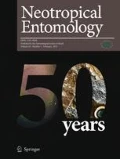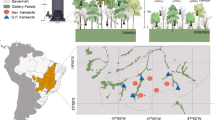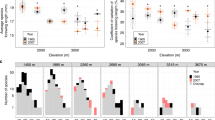Abstract
Biomass is an important indicator of various ecological factors in insect populations and communities. Although the utility of this variable is proven, it is usually dismissed in ecological studies, generally, because of the difficulty of measuring it. Considering that insect biomass is apparently declining worldwide, here, we aimed to test the accuracy of forewing length as an estimator of body mass in Neotropical Ichneumonidae to help in monitoring insect biomass. Forewing length and dry body mass were measured in 728 individuals from distinct localities in Venezuela and Ecuador. A clear log-linear relationship existed between the two variables, and a log-linear regression had significant and strong predictive power of mass based on wing length. To derive the final values of mass from predictions made using our equation, we used an exponential transformation. We present an R function for predicting mass from wing length. We consider our findings applicable to many Neotropical species of Ichneumonidae, and helpful especially when specimens are measured in dry collections.





Similar content being viewed by others
References
Aguiar AP, Santos BF (2010) Discovery of potent, unsuspected sampling disparities for malaise and Möricke traps, as shown for Neotropical Cryptini (Hymenoptera, Ichneumonidae). J Insect Conserv 14:199–206
Barros LM, Martins RT, Ferreira-Keppler RL, Gutjahr ALN (2018) Fresh and dry mass estimates of Hermetia illucens (Linnaeus, 1758) (Diptera: Stratyomidae) larvae associated with swine decomposition in urban area of Central Amazonia. Neotrop Entomol 47:478–483
Benke A, Huryn A, Smock L, Wallace J (1999) Length-mass relationships for freshwater macroinvertebrates in North America with particular reference to the southeastern United States. J N Am Benthol Soc 18:308–343
Brady CJ, Noske RA (2006) Generalised regressions provide good estimates of insect and spider biomass in the monsoonal tropics of Australia. Aust J Entomol 45:187–191
Brito JG, Martins RT, Soares KM, Hamada N (2015) Biomass estimation of Triplectides egleri Sattler (Trichoptera, Leptoceridae) in a stream at Ducke reserve, Central Amazonia. Rev Bras Entomol 59:332–336
Burgherr P, Meyer EI (1997) Regression analysis of linear body dimensions vs. dry mass in stream macroinvertebrates. Arch Hydrobiol 139:101–112
Carron A (2007) Correlation between wing measurements and dry body weight in male and female Ochlerotatus (Ochlerotatus) caspius (Pallas, 1771) (Diptera: Culicidae). Eur Mosq Bull 24:4–8
R Core Team (2018) R: a language and environment for statistical computing. R Foundation for Statistical Computing, Vienna https://www.R-project.org
Danforth BN (1989) The evolution of hymenopteran wings: the importance of size. J Zool 218:247–276
De Sassi C, Tylianakis JM (2012) Climate change disproportionately increases herbivore over plant or parasitoid biomass. PLoS One 7(7):e40557
Feest A, Aldred TD, Jedamzik K (2010) Biodiversity quality: a paradigm for biodiversity. Ecol Indic 10:1077–1082
Fraley C (2018). HDoutliers: Leland Wilkinson’s algorithm for detecting multidimensional outliers. R package version 1. https://CRAN.R-project.org/package=HDoutliers
Ganihar SR (1997) Biomass estimates of terrestrial arthropods based on body length. J Biosci 22:219–224
Gauld I, Fitton MG (1987) Sexual dimorphism in Ichneumonidae: a response to Hurlbutt. Biol J Linn Soc 31:291–300
Gilbert JDJ (2011) Insect dry weight: shortcut to a difficult quantity using museum specimens. Fla Entomol 94:964–970
Gowing G, Recher HF (1984) Length-weight relationships for invertebrates from forests in South-Eastern New South Wales. Aust J Entomol 9:5–8
Greenewalt CH (1962) Dimensional relationships for flying animals. Smithsonian Miscellaneous Collections 144:1–46
Hallmann CA, Sorg M, Jongejans E, Siepel H, Hofland N, Schwan H, Stenmans W, Müller A, Sumser H, Hörren T, Goulson D, Kroon H (2017) More than 75 percent decline over 27 years in total flying insect biomass in protected areas. PLoS One 12:e0185809
Heino J, Alahuhta J, Fattorini S (2019) Macroecology of ground beetles: species richness, range size and body size show different geographical patterns across a climatically heterogeneous area. J Biogeogr 46:2548–2557. https://doi.org/10.1111/jbi.13693
Heleno RH, Ceia RS, Ramos JA, Memmott J (2008) Effects of alien plants on insect abundance and biomass: a food-web approach. Conserv Biol 23:410–419
Jakob EM, Marshall SD, Uetz GW (1996) Estimating fitness: a comparison of body condition indices. Oikos 77:61–67
Jervis MA, Heimpel GE, Ferns PN, Harvey JA, Kidd NAC (2001) Life-history strategies in parasitoid wasps: a comparative analysis of “ovigeny”. J Anim Ecol 70:442–458
Johnson MD, Strong AM (2000) Length-weight relationships of Jamaican arthropods. Entomol News 111:270–281
Khatri D, He XZ, Wang Q (2009) Mating behavior and egg maturation in Diadegma semiclausum Hellen (Hymenoptera: Ichneumonidae). N Z Plant Prot 62:174–178
King BH, Burgess ER, Colyott KL (2018) Sexual size and shape dimorphism in three species of parasitoid wasps with burrowing females: Spalangia endius, Spalangia nigroaenea, and Spalangia nigra (Hymenoptera: Pteromalidae). J Insect Sci 18(5):1–6
Lister BC, Garcia A (2018) Climate-driven declines in arthropod abundance restructure a rainforest food web. Proc Natl Acad Sci U S A 115:E10397–E10406
Macgregor CJ, Williams JH, Bell JR, Thomas CD (2019) Moth biomass increases and decreases over 50 years in Britain. Nature Ecol Evol 3:1645–1649
Martins RT, Melo AS, Gonçalves JF Jr, Hamada N (2014) Estimation of dry mass of caddisflies Phylloicus elektoros (Trichoptera: Calamoceratidae) in a Central Amazon stream. Zoologia 31:337–342
Mazón M (2016) Taking shortcuts to measure species diversity: parasitoid Hymenoptera subfamilies as surrogates of species richness. Biodivers Conserv 25:67–76
Mazón M, Alvarez P, Santin J, Aguirre N (2017) Insectos vs suelo: la importancia de elegir indicadores para el monitoreo de la restauración ecológica. In: Mazón M, Maita J, Aguirre N (eds) Restauración del paisaje en Latinoamérica: experiencias y perspectivas futuras. Memorias Primer Congreso Ecuatoriano de Restauración del Paisaje. Ediloja, Loja, pp 144–158
Miller WE (1977) Wing measure as a size index in Lepidoptera: the family Olethreutidae. Ann Entomol Soc Am 70:253–256
Miller WE (1997) Body weight as related to wing measure in hawkmoths (Sphingidae). J Lepid Soc 51:91–92
Orihuela-Torres A, Ordóñez-Delgado L, Brito J, López F, Mazón M, Freile JF (2018) Ecología trófica del búho terrestre Athene cunicularia punensis (Strigiformes: Strigidae) en el archipiélago de Jambelí, provincia de El Oro, suroeste de Ecuador. Rev Peru Biol 25:123–130
Pearson K (1895) Notes on regression and inheritance in the case of two parents. Proc R Soc Lond B 58:240–242
Petersen V, Marchi MG, Natal D, Marrelli MT, Barbosa AC, Suesdek L (2016) Assessment of the correlation between wing size and body weight in captive Culex quinquefasciatus. Rev Soc Bras Med Trop 49:508–511
Potts SG, Biesmeijer JC, Kremen C, Neumann P, Schweiger O, Kunin WE (2010) Global pollinator declines: trends, impacts and drivers. Trends Ecol Evol 25:345–353
Powney GD, Carvell C, Edwards M, Morris RKA, Roy HE, Woodcok BA, Isaac NJB (2019) Widespread losses of pollinating insects in Britain. Nat Commun 10:1018
Radtke MG, Williamson GB (2005) Volume and linear measurements as predictors of dung beetle (Coleoptera: Scarabaeidae) biomass. Ann Entomol Soc Am 98:548–551
Rasnitsyn AP (1978) Predislovie In: Heinrich GH (editor) Vostochnopalearkticheskie pereponchatokrylye nasekomye podsemeistva Ichneumoninae. Leningrad: Nauka Press, Leningradskoe otdelenie: 3-5
Rozen A, Sobczyk L, Weiner J (2015) The effect of pre-analytical treatment on the results of stoichometric measurements in invertebrates. Appl Entomol Zool 50:393–403
Saint-Germain M, Buddle CM, Larrivée M, Mercado A, Motchula T, Reichert E, Sackett TE, Sylvain Z, Webb A (2007) Should biomass be considered more frequently as a currency in terrestrial arthropod community analyses? J Appl Ecol 44:330–339
Sánchez-Bayo F, Wyckhuys KAG (2019) Worldwide decline of the entomofauna: a review of its drivers. Biol Conserv 232:8–27
Santos A (2013) Indicating assemblage vulnerability and resilience in the face of climate change by means of adult ground beetle length-weight allometry over elevation strata in Tenerife (Canary Islands). Ecol Indic 34:204–209
Schmidt-Nielsen K (1984) Scaling: why is animal size so important? Cambridge University Press, Cambridge
Shapiro SS, Wilk MB (1965) An analysis of variance test for normality (complete samples). Biometrika 52:591–611
Shortall CR, Moore A, Smith E, Hall MJ, Woiwod IP, Harrington R (2009) Long-term changes in the abundance of flying insects. Insect Conserv Diver 2:251–260
Smock LA (1980) Relationships between body size and biomass of aquatic insects. Freshw Biol 10:375–383
Townes HK (1969) The genera of Ichneumonidae, Part 1. Ann Arbor: The American Entomological Institute
Townes HK (1972) A light-weight malaise trap. Entomol News 18:239–247
Yang LH, Gratton C (2014) Insects as drivers of ecosystem processes. Curr Opin Insect Sci 2:26–32
Yu DS, van Achterberg K, Horstmann K (2012) World Ichneumonoidea 2011. Taxapad 2012. Database on flash-drive. Ottawa, Ontario, Canada
Acknowledgments
The authors would like to thank Ingrit Correa and Antonia García, who gave us access to the Venezuelan and Ecuadorian labs, respectively, and to Juan Dario Quinde and Jose Reátegui for helping with the measurements. We also would like to thank Jorge Soberón and A. Townsend Peterson for help in reviewing the statistical methods used and in proofreading the manuscript.
Author information
Authors and Affiliations
Contributions
All the authors designed the study. MM collected the data, and CNP and MEC performed the data analyses. All the authors wrote and reviewed the manuscript.
Corresponding author
Additional information
Edited by Anne-Nathalie Volkoff – INRA
Publisher’s Note
Springer Nature remains neutral with regard to jurisdictional claims in published maps and institutional affiliations.
Edited by Anne-Nathalie Volkoff – INRA
Electronic Supplementary Material
ESM 1
(DOCX 48.1 kb)
Rights and permissions
About this article
Cite this article
Mazón, M., Nuñez-Penichet, C. & Cobos, M.E. Relationship Between Body Mass and Forewing Length in Neotropical Ichneumonidae (Insecta: Hymenoptera). Neotrop Entomol 49, 713–721 (2020). https://doi.org/10.1007/s13744-020-00784-9
Received:
Accepted:
Published:
Issue Date:
DOI: https://doi.org/10.1007/s13744-020-00784-9




